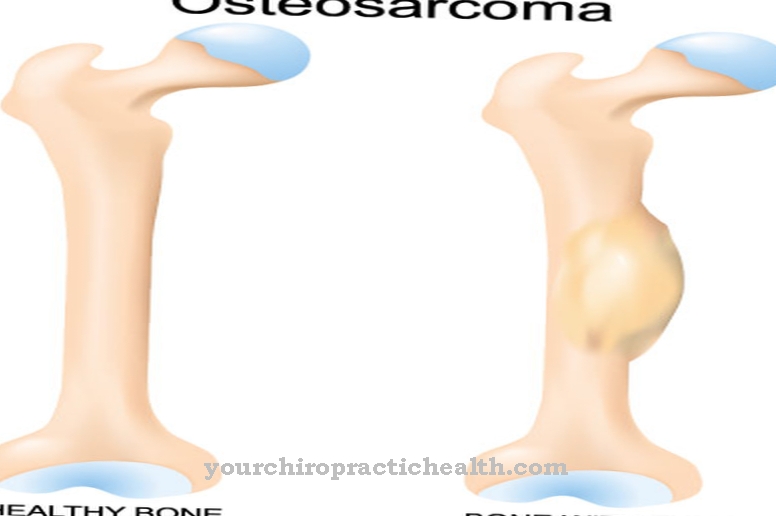At the PFAPA syndrome is a disease that typically occurs in children with severe attacks of fever and certain accompanying symptoms. Since fever is a common symptom in pediatricians' practice, differential diagnosis is considered difficult. What exactly triggers the fever attacks in PFAPA syndrome in childhood is still unknown.
What is PFAPA Syndrome?

© Tomsickova - stock.adobe.com
Key symptom of PFAPA syndrome is a so-called recurrent fever in toddler age. These attacks of fever, which appear again and again at seemingly specific intervals, lead parents to go to a pediatric practice with the child.
The pediatrician may suspect the existence of a PFAPA syndrome, for example, if the parents can give specific times for the next occurrence of a fever in an attack-free interval. Since febrile conditions in the pediatrician practice often occur for no apparent reason from the medical history or other clinical symptoms, the differential diagnosis is very difficult.
Numerous examinations are therefore necessary in the sense of an exclusion diagnosis so that the presence of a PFAPA syndrome can be confirmed or not. Although the bouts of fever with a high fever of up to 40 degrees Celsius can be very frightening for the parents, it is known that the PFAPA syndrome is benign and that no long-term damage or long-term effects are to be expected. With increasing age, the fever attacks can disappear completely and then do not recur in the course of further life.
causes
PFAPA syndrome is considered a rare pediatric disease. Nevertheless, it must be assumed that a not inconsiderable percentage of sick children are not correctly diagnosed. This is due on the one hand to the unspecific febrile course of the disease, on the other hand to the cause that has not yet been clearly identified.
The PFAPA syndrome was first described in the USA in 1987 as a fever of unknown origin in children. According to the current state of knowledge, the further physical and mental development and also the growth of the children is not influenced by the occurrence of a PFAPA syndrome.
However, clear signs of inflammation and so-called autoantibodies can be found in the blood of the affected children during the fever attacks. Experts now assume that the PFAPA syndrome is an autoimmune disease. That would also explain the intermittent fever.
However, it is not known exactly against which endogenous structures autoantibodies are formed, which in turn lead to the formation of immune complexes and thus to an inflammatory defense reaction of the body. In addition, the genetic information plays a role in the development of the disease. Today it must be assumed that the PFAPA syndrome is a genetic disorder of immune regulation.
Symptoms, ailments & signs
The main symptom of the disease is recurrent, intermittent fever, which occurs suddenly and in attacks. Early onset is also typical, mostly in children who have not yet reached the age of five. The time intervals between the fever attacks are usually completely symptom-free.
Through further series examinations, three main symptoms, in addition to fever, of the PFAPA syndrome have now been established. These include inflammation of the gums, stomatitis, sore throat, pharyngitis and associated swelling and inflammation of the cervical lymph nodes, lymphadenitis.
In more than two thirds of all patients with PFAPA syndrome, these three key symptoms were present in addition to fever. Additional complaints and signs of the disease appear in the form of non-specific abdominal and muscle pain, as well as in the form of rashes that can manifest themselves all over the body.
In children who show these skin symptoms in connection with the fever, misdiagnosis can occur particularly frequently. In the acute fever, the typical signs of inflammation such as leukocyte proliferation, reactive left shift and increased blood cell sedimentation rate, ESR, can be regularly detected during blood tests in the laboratory.
Diagnosis & course of disease
The suspected diagnosis is initially based on the main clinical symptom of recurrent fever together with the various accompanying symptoms. Pharyngitis, stomatitis, and cervical lymphadenitis can be diagnosed by inspection and palpation. Laboratory tests are required to confirm the diagnosis.
Part of the classic course of the disease is that the fever attacks occur every two to twelve weeks and each last for about five days. Overall, the course of the disease is benign, despite the drama, so that long-term consequences are not to be expected. In addition, after the age of 10, spontaneous remissions often occur, i.e. the abrupt and permanent absence of symptoms.
Complications
As a result of the PFAPA syndrome, the children affected primarily suffer from a very high fever. This fever occurs mainly in bouts and can significantly reduce the quality of life of the person affected. In many cases, this also delays the patient's development. The PFAPA syndrome can also lead to discomfort to the teeth and inflammation of the gums.
It is not uncommon for those affected to suffer from inflammation in the throat and severely swollen lymph nodes. Pain in the stomach or stomach can also be felt. Furthermore, the muscles ache and the children suffer from rashes on the skin. The rashes can also lead to inferiority complexes or reduced self-esteem in the children.
In some cases, PFAPA syndrome also leads to teasing or bullying. Direct treatment of this disease is usually not possible. With the help of medication, however, the attacks can be limited. There are no particular complications. However, it cannot be predicted whether the PFAPA syndrome will have a negative impact on the life expectancy of the person affected.
When should you go to the doctor?
Children and toddlers belong to the risk group for PFAPA syndrome. If they break out repeatedly and in episodes of fever, the symptoms should be clarified by a doctor. Particularly high fever must be examined by a doctor. Life-threatening conditions can occur and there is a risk that consequential damage will develop. Consultation with a doctor is therefore necessary. Often there is spontaneous healing and, as the disease progresses, another sudden fever. To ensure that the child is well and adequately cared for during these phases, the parents should obtain comprehensive information from a doctor.
The characteristic of PFAPA syndrome is the sudden appearance of the symptoms. There are no prior warning signs or indications to be taken into account.The child needs medical help in the event of inflammation, discomfort in the mouth and throat or changes in the skin texture. If you experience abdominal pain or muscle disorders, the symptoms should be discussed with a doctor.
Swollen lymph glands or swellings on the neck indicate a health impairment. If the symptoms persist or if they increase in intensity, a doctor is required. Particular care should be taken with rashes, open wounds or pus formation. If there is no sterile wound care, blood poisoning can occur. This is a life-threatening condition that requires rapid trade.
Therapy & Treatment
A causal, i.e. cause-related therapy, is still not possible with the PFAPA syndrome. All therapeutic attempts to prematurely interrupt the fever attacks and the accompanying symptoms are therefore symptomatic. In practice it can be seen in particular that the symptoms do not respond to antibiotics or to non-steroidal anti-inflammatory drugs. This also suggests that the PFAPA syndrome is not triggered by bacteria.
The administration of cortisone, especially the cortisone derivative prednisone, made the fever episodes disappear within a very short time. This confirmed the suspicion that the PFAPA syndrome is a special form of an autoimmune disease. Therefore, the high-dose administration of cortisone as an infusion is considered the drug of choice.
Outlook & forecast
The PFAPA syndrome, which occurs more frequently in children, is an often undetected fever. Most paediatricians do not recognize this disease. Regardless, the prognosis is not bad. The recurring fever attacks can last for several years. They are treated symptomatically and heal after a maximum of eight years. In rare cases, however, those affected have struggled with the sequelae of the PFAPA syndrome even as adults.
PFAPA syndrome comes on in bursts with symptoms that are often not recognized as related. There are attacks of fever, sore throat and tonsillitis, canker sores in the mouth and swollen cervical lymph nodes. Such symptoms are not suspect in children. The PFAPA syndrome is usually misinterpreted as a consequence of the common cold or tonsillitis and treated accordingly.
Since the symptoms soon subside, the real cause is not recognized. The same symptoms recur periodically over a period of five to eight years. After a single administration of a corticosteroid when the fever begins, the fever subsides. The other complaints also disappear. The problem is that this only helpful therapy often has unpleasant consequences. Half of the patients treated in this way suffer from a worsening of the disease symptoms for reasons that are still unknown.
The more corticosteroid therapy is used, the more likely it is that the frequency of fever attacks increases. These now occur once or twice a week.
prevention
According to the current state of knowledge, parents and doctors cannot do anything to prevent the disease from breaking out. In order to save the affected children from suffering for years because of the attacks of fever, the PFAPA syndrome should be diagnosed clearly and as early as possible.
Aftercare
In the case of PFAPA syndrome, follow-up measures are significantly limited in most cases, as the exact cause of the disease is not yet known. Therefore, parents and their children should consult a doctor very early in order to prevent further complications and complaints. The earlier a doctor is consulted, the better the further course of the disease.
Most children are dependent on taking various medications. It is important to ensure the correct dosage in order to permanently alleviate the symptoms. Parents, in particular, need to properly monitor medication intake. A doctor should be consulted immediately if anything is unclear or if there are side effects.
Regular checks by a doctor are also very useful in order to permanently monitor the child's condition. The affected children should rest and take it easy. In any case, efforts should not be made. As a rule, no further follow-up measures are necessary. With proper treatment, PFAPA syndrome usually does not reduce the patient's life expectancy.
You can do that yourself
The PFAPA syndrome initially requires drug treatment. This can be supported by various self-help measures. In addition, the sick person should drink a lot. The hydration replenishes the body's mineral reserves and prevents dehydration. Two to three liters per day are ideal, with mineral water, herbal teas and diluted fruit juices being consumed.
High fevers can be reduced by using leg wraps. For this purpose, two towels are dipped in cool water and wrapped around the calves after wringing them out for a short time. These measures should be applied three times a day. In general, it should be ensured that the fever does not rise to 39.5 degrees Celsius or higher. If the fever is high, the doctor should be informed. Home remedies are also not recommended for any accompanying symptoms such as headaches or body aches.
If you have PFAPA syndrome, you should not do sports. The patient has to cure the fever completely and sleep a lot during the illness. It is important to avoid stress as well as irregular sleep and the consumption of luxury foods. If the fever gets worse or is accompanied by unusual symptoms, the doctor must be informed.

.jpg)



.jpg)



















.jpg)


